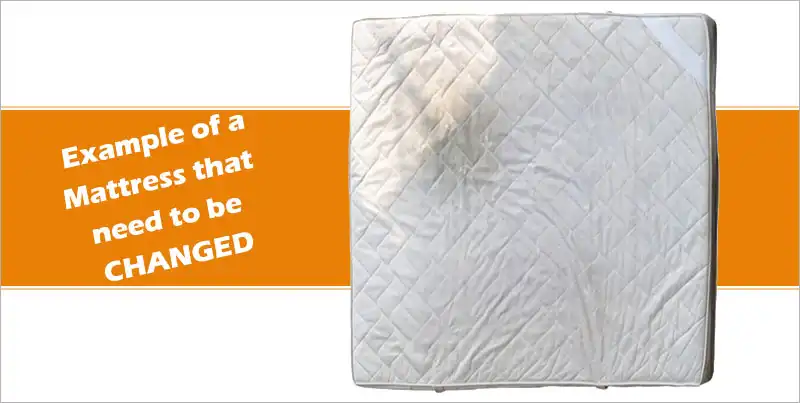Getting a good night’s sleep is vital for both physical and mental well-being. However, it’s important to recognize the crucial role your bed plays in achieving restful sleep. An aged or deteriorating mattress can lead to various issues, such as back pain, poor sleep quality, and even allergies. On the other hand, investing in a premium quality mattress can enhance your sleep and overall health. Therefore, it’s crucial to replace your mattress when it’s old, of inadequate quality, or no longer suitable for your needs.
In this article, we will explore the top 10 indicators that suggest it’s time to replace your mattress. We’ll cover warning signs such as sagging, indentations, excessive noise, and unpleasant odors. Whether you’re a side sleeper, stomach sleeper, or back sleeper, continue reading to learn how to identify when it’s time to upgrade your mattress.
1. You’re Not Comfortable
As a mattress age, its foams and springs can lose shape, support, and resilience, causing it to sink and become uneven. This can make it difficult to find a comfortable position, leading to tossing and turning during the night. Furthermore, as people’s needs and preferences change over time, a mattress that once provided a pleasant and supportive night’s sleep may no longer do so. If you’re finding it uncomfortable to sleep, it may be time to replace your mattress. Search for the right mattress as per your requirement, such as a mattress specifically designed for individuals with back pain or one that can be adjusted to meet your preferences.
2. You Wake Up with Discomfort
Experiencing aches and pains upon waking may indicate that your bed no longer provides the necessary support for your body. As mattresses age, their materials can deteriorate, lose shape, and fail to offer adequate support. This can lead to misalignment of the spine and the development of pressure points, resulting in discomfort upon waking. Additionally, an old mattress may no longer provide sufficient comfort and contouring, leading to aches and pains. In such cases, it’s advisable to replace your old mattress with an orthopedic one that offers proper support, comfort and improves overall sleep quality.
3. Visible Sagging or Lumps
Sagging and the formation of lumps are early signs that the materials inside your mattress have worn out or lost their shape. Sleeping on such a mattress can be challenging due to the discomfort caused by uneven surfaces and pressure points on the body. You may find yourself tossing and turning all night, struggling to find a comfortable position. Furthermore, sagging indicates that the mattress is nearing the end of its usable life and no longer provides the necessary support and comfort for a good night’s sleep. It’s best to invest in a new mattress that can help you sleep better, alleviate aches and pains, and provide the support and comfort your body needs.
4. It’s More Than 7-10 Years Old
The average lifespan of a mattress is 7-10 years. If your mattress is older than this, it’s likely time to replace it. Over time, the foam and springs can wear out, lose support and comfort, and accumulate dust mites and allergens, which can adversely affect your health. Additionally, as your needs and preferences change over time, a mattress that once provided a good night’s sleep may no longer be comfortable or supportive.
5. Your Bed Makes Noise When You Move
If your bed produces a noise when you shift positions, it may indicate that the mattress’s internal structure, particularly the coils or springs, is deteriorating, damaged, or broken. When the coils or springs lose their form or break, the bed can creak or make other noises as you move, causing disturbances during sleep. Replacing the mattress is recommended to ensure a peaceful night’s sleep.
6. You Feel Springs or Coils Poking or Pressing into Your Body
Sensing the springs or coils of your mattress poking or pressing against you can lead to pressure points and severe back pain. The presence of poking coils indicates that the springs may be cracked or that the foam layers covering them have worn out, failing to cushion the springs adequately. Springs are essential support components in Bonnell spring and Pocket Spring Mattresses, and their degradation reduces the mattress’s ability to provide proper support and comfort. This can result in back pain and other discomforts. Furthermore, worn-out coils may generate noise when you move in bed, further disrupting your sleep.
7. You Have Trouble Sleeping
Your bed significantly impacts the quality of your sleep and may be the cause of your sleeping difficulties. If you struggle to sleep, experience insufficient sleep, or wake up feeling more tired than rested, it indicates that your bed is not providing the restful sleep you need. There could be several reasons for this, such as an aged and uncomfortable mattress or a lack of support and comfort. These factors can make it challenging to find a comfortable position, leading to restlessness throughout the night. Additionally, sleeping on a mattress that is either too soft or too firm can be problematic. If you’ve been experiencing sleeping difficulties, consider replacing your mattress with one that better suits your requirements, such as a customized mattress designed for individuals with back pain or one that can be adjusted according to your preferences.
8. You Notice Indentations
Indentations on your mattress indicate that the internal components, such as foam or cushioning, have compressed and lost their structure and support over time. This can make it difficult to find a comfortable posture and create uneven surfaces that generate pressure points, leading to back pain, shoulder pain, and other discomforts. Indentations can also suggest that the mattress is losing its ability to offer proper spinal alignment, resulting in persistent back pain.
9. You Have Allergies or Asthma
If you suffer from allergies or asthma and experience allergic reactions or breathing difficulties while sleeping, it could be due to an unhygienic and dirty mattress. Over time, mattresses can accumulate dust mites, mold, and other allergens, leading to allergic reactions or asthma symptoms. Dust mites thrive in warm, humid environments and feed on dead skin cells, making your bed an ideal breeding ground. These allergens can exacerbate symptoms and even trigger asthma attacks. Opting for a hypoallergenic or allergen-resistant mattress, or one treated to reduce the presence of dust mites, mold, and other allergens, can help alleviate these symptoms.
10. Your Bed Has an Unpleasant Odor
If your mattress emits an unpleasant odor, it’s likely due to the presence of mold, mildew, bacteria, or other organic matter. Over time, mattresses can absorb moisture, especially without proper ventilation. They can also accumulate body oils, sweat, and other organic substances, promoting bacterial growth and unpleasant odors. These odors not only affect your comfort but can also pose health risks. In such cases, it’s crucial to replace your old mattress with a new one that offers high permeability and ventilation, creating a healthy and pleasant sleeping environment while preventing mold, mildew, and odors.
Your bed plays a significant role in your sleep environment and has a substantial impact on the overall quality of your sleep. It should provide adequate support and comfort, enabling you to enjoy a restful night’s sleep. However, over time, a mattress can lose its shape, support, and comfort, resulting in restless sleep, back pain, and other discomforts. If you observe any of the mentioned signs, such as sagging, noise, unpleasant odors, indentations, or difficulties sleeping, then you can well understand that the time has come to buy a new mattress. By investing in a new mattress, you can ensure that you obtain optimal sleep, leading to improved health and overall well-being.



